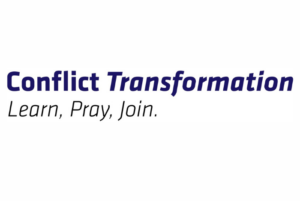Paula Holtzinger provides insight on how to effectively handle conflict, through listening, leaning in and utilizing resources.
This blog is part of the ongoing Learn, Pray, Join: Climate Justice: Conflict Transformation series.
 Paula Holtzinger is the director of off-campus programs at Messiah University, in Grantham, Pennsylvania, where she also works closely with the Young Peacemakers Academy. She is a graduate of Eastern Mennonite University’s Center for Justice and Peacebuilding and Messiah University’s Peace and Conflict Studies Program. Paula attends Harrisburg (Pennsylvania) First Church of the Brethren. She is passionate about integrating restorative and trauma-informed practices into everything she does, including her work to help students engage in experiential cross-cultural learning opportunities, domestically and globally.
Paula Holtzinger is the director of off-campus programs at Messiah University, in Grantham, Pennsylvania, where she also works closely with the Young Peacemakers Academy. She is a graduate of Eastern Mennonite University’s Center for Justice and Peacebuilding and Messiah University’s Peace and Conflict Studies Program. Paula attends Harrisburg (Pennsylvania) First Church of the Brethren. She is passionate about integrating restorative and trauma-informed practices into everything she does, including her work to help students engage in experiential cross-cultural learning opportunities, domestically and globally.
_________________________________________________
The word “conflict” tends to invoke a variety of reactions: anxiety, apprehension, avoidance or, sometimes, hypervigilance. And while conflict can be challenging or uncomfortable, it is quite natural, normal and even healthy.
Rather than fearing conflict itself and trying to avoid it, we must learn how to address conflict and communicate in productive ways, in order to not only mediate conflict but to ultimately transform it.
When discussing conflict transformation, I tend to utilize a broad toolkit of resources. The resources I draw from depend on who my audience is, and whether I’m discussing a specific conflict or speaking about conflict in a more generalized sense. An important starting point, though, regardless of the audience, is learning about different conflict styles. Understanding conflict styles is imperative to both better understanding oneself — how we respond to conflict, what our tendencies are, our areas of growth — and better understanding conflict styles that may differ from our own.
Some helpful models for understanding conflict styles are the Kraybill Conflict Style Inventory and the Thomas-Kilmann’s Conflict Mode Instrument. In Mennonite Central Committee’s 2021 publication, “Peaceful Practices: A guide to healthy communication in conflict,” MCC provides a model that incorporates elements of each of these and other resources to create a matrix. This conflict style matrix includes an animal and a traffic sign that is associated with each style, as visual metaphors for understanding each of the five styles: accommodating, collaborating, compromising, avoiding and competing.
Our conflict styles are deeply influenced by the various identities we hold and the groups that we are a part of. People tend to think that our personalities determine how we approach conflict, and while that is certainly one component or ingredient in the mix, there are other important factors that shape our style, in addition to our family of origin, our cultural norms and values, and the situations that we find ourselves in.
Some additional tools that I utilize for effective conflict transformation are principles and practices of restorative justice, trauma-informed approaches and the science of resilience. Developing tangible resilience strategies, such as self-regulation and somatic-sensory exercises, gratitude practices, mindfulness, among others, are critical for effective conflict transformation.
I’m a firm believer that true conflict transformation can only happen when true listening takes place.
With that said, here are some other critical ingredients in effective conflict transformation: active listening and curiosity, empathy and compassion, vulnerability, self-reflexivity, creativity, and a commitment to honoring the dignity and worth of each person.
Another tool that I find particularly helpful is the Dugan Nested Model for conflict analysis. This model helps us go beyond the surface-level context to unpack the broader systems that our conflict is “nested” within structurally. Understanding the wider, more holistic picture of stressors and triggers for conflicts, the historical nature of issues, and how the systems we live in impact us offer another lens with which to approach and understand the depth and reality of why conflict manifests the way it does. Taking the time to think about conflict in a different way, or see it through a different lens allows us to approach that conflict with a more comprehensive understanding.
Lastly, another core ingredient, which is the very foundation of my own approach to conflict transformation and living in healthy community, is the doctrine of the imago dei. Imago Dei is a Latin phrase that translates to the “image of God.” In Genesis 1:27, when God created humanity, we were created with a special distinction, in the very likeness and essence of Godself. This theological understanding highlights the beauty of our relationship with God and calls us into special relationship with one another, as well. If all humankind was created in the imago dei, then there is an imperative for us to recognize the beauty, dignity and worth of each person and to operate from a place of mutual respect and care for one another. This concept also resonates deeply with the gospel message and commandment to love God and love neighbor. Jesus teaches us, again and again, throughout the gospels, what he means by that, and he challenges his followers to do as he has done.
One of my favorite passages of Scripture is in Matthew 5, the Beatitudes. Jesus proclaims that we are blessed when we’re at the end of our rope, because with less of us, there’s more of God. We are blessed when we are full of compassion for others, when we focus our minds and hearts on him, and when we “show people how to cooperate instead of compete or fight” (Matthew 5:9, MSG). Immediately following the Beatitudes, Jesus calls his disciples to be the salt and light in the world. So in a world full of conflict, division, and polarization, it is my hope and urge for us now, too, to focus on our Prince of Peace and work to build healthy communication, through which we don’t shy away from conflict but work to transform it, through listening and leaning in.

“Learn, Pray, Join: Conflict Transformation” provides tools and resources to help MC USA church communities peacefully engage in dialog around difficult and divisive topics. By embracing restorative justice and modeling healthy communication, we seek to witness to God’s peace, as we build diverse communities to serve and follow Jesus.
You are invited to get involved with Learn, Pray, Join: Climate Justice: Conflict Transformation.
Support Mennonite Church USA’s Peace and Justice Initiatives by giving here.
The views and opinions expressed in this blog belong to the author and are not intended to represent the views of the MC USA Executive Board or staff.
Interested in submitting a blog for Menno Snapshots? Please see our blog guidelines here.

